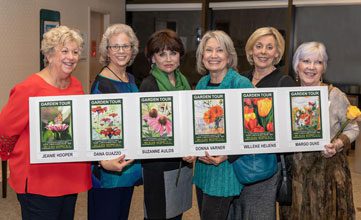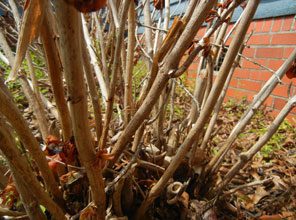 Everybody welcomes spring with joy. Every year. I do, too.
Everybody welcomes spring with joy. Every year. I do, too.
But here comes the Humbug part: Hidden in the mental rainbow created by spring is a long, depressing list of garden to-do’s. Not the fun part of planting and dividing, but the tedious chores that have to be accomplished by spring’s end. By then, anything left undone is likely to stay undone until autumn. Only the most intrepid of us can accomplish much in the garden when the hot weather begins. And it seems to begin earlier every year. Spring is supposed to last until June 21st, but we had 80 degree weather in February!!
So where do we start? A stroll around your garden is good. And it’s a good idea to take pen and paper. If your property is large, it will probably take two or three strolls. You’ll need to re-check areas as the weather allows dormant plants to come alive, and herbaceous ones to peek through the earth.
Although winter blackened foliage really looks ratty, don’t be too quick to remove it. Wait until you’re fairly certain we won’t have another hard freeze. My daughter-in-law phoned that it snowed in Chicago last week. Ugly as it is, it provides protection from further winter damage.
The landscape people and just the wind have probably blown fallen leaves, pine needles and other garden detritus into all your flower beds and shrubs. Tempting as it is just to leave it there and call it easy mulch, don’t. Over time, you’ll find the build-up has buried the root flare of trees and shrubs, and made it difficult for anything to get essential water, oxygen and nutrients down to the roots. Rake it out and either compost it or burn it. Ashes are about 20% calcium and 5% potassium, and tend to increase soil Ph, so use them judiciously on plants that like lime. My bananas love them!
Now is the time to examine your shrubs and look at the branches for the three D’s: dead, damaged or diseased. These need to pruned away. No need to wait until after bloom time. They need to be gone. Now.
If you grow roses, Valentine’s Day is a good reminder to prune them back to pretty much what they looked like when you bought them. This doesn’t apply to landscape roses, such as the Knock-Out series. Just treat them for the three D’s.
Also, look for lichen on your trees and shrubs. Lichen itself is not harmful, but it’s a sign that the plant itself is under stress. Look for the cause. It very well may be that it’s mulch-buried, as noted above. Or, it’s losing the competition for water and nutrients to another, larger nearby plant. Early spring is a good time to fertilize. They need nourishment, too, and our natural soil really does precious little to provide it. Be sure that it’s getting its proper share of irrigation, too. Sprinkler heads often become misaligned.
Don’t be fooled into buying ‘Weed and Feed’ products for your lawn. Weed prevention products and fertilizers should be applied at different times. Weed prevention in very early spring, and wait to fertilize until the turf starts to green up.
Check your irrigation system’s rain gauge and make sure it’s working properly. If you don’t have a well, you could be spending a lot of money on wasted water. It’s far better to irrigate twice a week for a half hour than 15 minutes daily or every other day. Roots need to migrate down into the soil, and shallow, frequent irrigation keeps the roots at the surface where the livin’ is easy. An irrigation system break-down in the middle of a heat wave or drought could irretrievably damage your lawn.
By the time I get this far along, I’ve pretty well used up all of my will power to continue, so it’s time to take a break and look at the returns on my labor investment.
My garden doesn’t use words to show it’s grateful for my attentions, but it says so in other ways. The branches of trees and shrubs are fattening up to burst into leaf or flower. Clumps of bulbs and perennials that I have divided and transplanted are enjoying the room to stretch out with renewed vigor. The Johnny Jump-Ups are jumping all over the place and I’m delighted to have them do it.
I’ve spied several Camellia babies around mother plants. As soon as they get a little bigger, I can pot them up and share them with friends. I spread the spent blossoms from Farfugiums around last fall, and some have actually germinated!
So like Scrooge, I’ve put the Humbug away, put a smile on my face and the joy back in my heart. If we didn’t have something to compare it to, how would we know what happiness is?
Happy Gardening!









